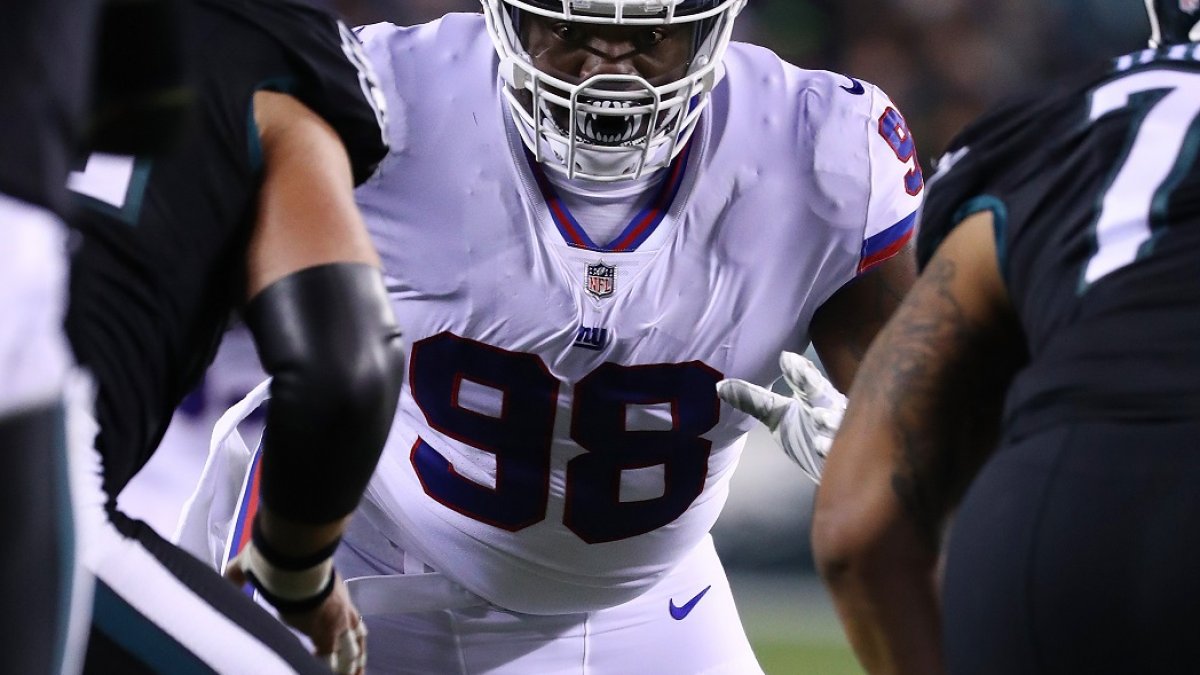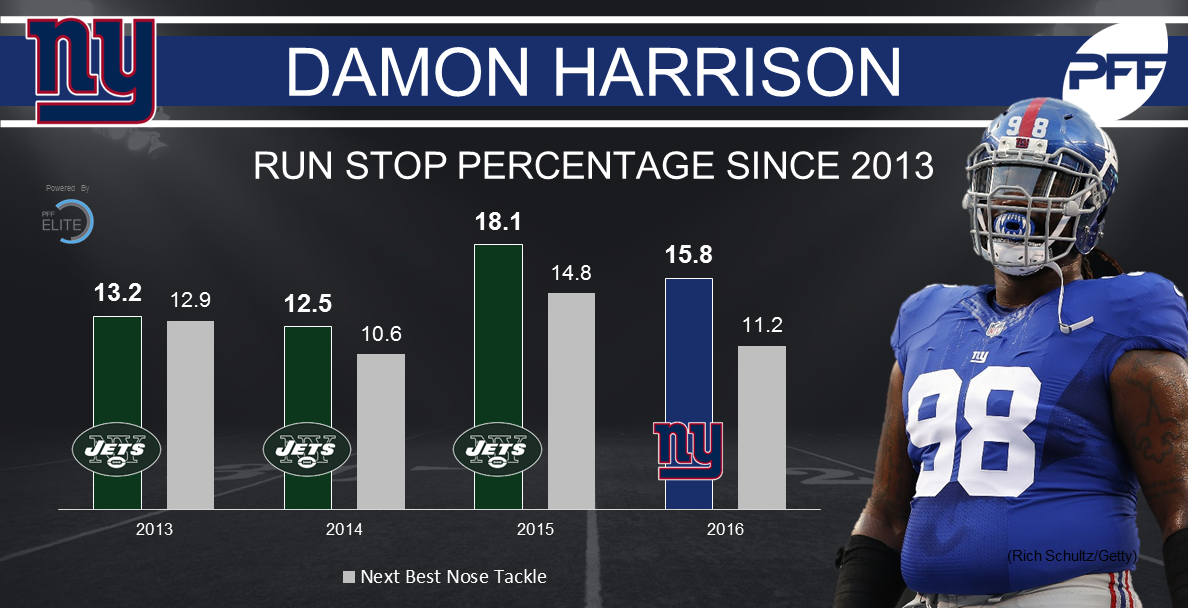Senior Analyst Mike Renner returns with his “Teaching Tape” series, a weekly feature in which he explains how and why the best in the NFL are successful at what they do. Renner’s third Teaching Tape article of the 2017 offseason dives into the incredible playmaking ability of New York Giants nose tackle Damon Harrison.
When it comes to playmaking nose tackles in the NFL today, there’s Damon Harrison, and then there’s everyone else. Through multiple different defensive coordinators and varying schemes/alignments, one thing has remained constant, Snacks has been the best run-stuffing nose tackle in the NFL. The chart below should make that clear enough:
Harrison has led all defensive tackles in run-stop percentage for each of the past four seasons. The past two, it hasn’t even been close.
While making plays as a nose tackle is always a welcome addition, no one wants a playmaker who is going to consistently compromise the integrity of the defense. Harrison gets the freedom to do what he does because defensive coordinators trust him to do the little things correctly as well. And few do those little things as well as Snacks.
Taking on double teams
Double teams are part and parcel of playing the nose tackle position. You won’t find a fan in the NFL who doesn’t think his favorite nose tackle isn’t double-teamed every play. That’s because every nose tackle gets double-teamed on almost every run play. When most centers are ceding 30-50 pounds to the man across from them, offense can’t afford not to. Most run concepts simply won’t work if your center’s butt is three yards deep in the backfield. If you can’t hold up to double teams, you won’t play nose tackle in the NFL.
When taking on double teams there are two universal tenets:
- Don’t cede ground
- Don’t lose your gap
Some coaches would argue that grabbing the guard/center and keeping the linebackers clean would be a third, but it’s far from universally coached. This technique was famously the reasoning given for Albert Haynesworth between the difference in the quality of his play going from Tennessee to Washington. Harrison certainly isn’t grabbing both ends of a double team, but with his unique ability to still make plays even against double teams, why would you ask him to?
One of only NTs in league who can consistently finish plays, even versus double teams pic.twitter.com/MaJ1TrxiGo
— Mike Renner (@PFF_Mike) May 31, 2017
Harrison’s success against double teams starts with block recognition. As a 0-tech — like he played often with the Jets — that was fairly easy as all he needed to do on most plays was attack the center. As a 1-tech though with the Giants, Harrison could get blocked by either the center or guard initially. The key for Harrison is to find the lineman flowing his way, engage him fully, then stand his ground. ![DamonDT1-1[4237]](https://media.pff.com/2017/05/DamonDT1-14237.png)
![DamonDT1-2[4236]](https://media.pff.com/2017/05/DamonDT1-24236.png)
![DamonDT1-3[4235]](https://media.pff.com/2017/05/DamonDT1-34235.png)
![DamonDT1-4[4234]](https://media.pff.com/2017/05/DamonDT1-44234.png) Once engaged, Harrison uses the offensive lineman’s own weight as an anchor. If another lineman engages or goes for a bump on the nose tackle, Snacks maintains his grip on the first lineman and uses that interaction to stay balanced. It’s not an easy task by any means, but Harrison makes it look that way often enough.
Once engaged, Harrison uses the offensive lineman’s own weight as an anchor. If another lineman engages or goes for a bump on the nose tackle, Snacks maintains his grip on the first lineman and uses that interaction to stay balanced. It’s not an easy task by any means, but Harrison makes it look that way often enough.
Gap awareness
On the rare plays where the nose tackle isn’t double-teamed, they aren’t all of a sudden given free rein to attack ball carriers. Danny Shelton is one of the best young, budding nose tackles in the league today. The biggest area he still needs to develop in though is patience. If you’re going to cross the face of an offensive lineman to make a play outside of your gap, you better make sure the running back is headed for that gap. You also must separate cleanly. If both those things aren’t present, the defense can be compromised. Take the play below from Cleveland’s Week 6 matchup with the Titans.
Impatience in run D = loss of gap control pic.twitter.com/M6UogOsIPN — Mike Renner (@PFF_Mike) May 31, 2017
Shelton stacks left guard Quinton Spain from the snap and is in complete control of his A-gap. The young nose tackle gets greedy though and tries to shed immediately to make a play. Because Spain doesn’t allow clean separation, Shelton is all of a sudden sealed out of the gap he was supposed to defend in the first place. The running back finds this and ducks through it. Shelton is saved by a nice play from linebacker Christian Kirksey, but if the center had executed his assignment it would have been a big run.
Harrison rarely, if ever, gets caught out of place like this. On many snaps he’s content to have complete control of his gap and won’t even attempt to shed over the top. It’s only when he knows the running backs path is taking him to a gap that Harrison could also get to that Snacks will go for the kill shot.
Uncoachable finishing ability
There comes a point in Harrison’s game — like any elite player — where you can’t teach what he does. Only so many human beings were made to be 6-foot-4, 350 pounds, with superior strength. It’s rare to see a one-on-one interaction that Harrison isn’t in complete control over. The word I’ve used over and over again is “clean.” Many times you’ll see nose tackles in control of a center or guard, but fail to end the play with a stop. Harrison not only controls offensive linemen, but he maintains separation so that the center or guard couldn’t get a handful of Snacks’ jersey even if they tried. When executed correctly, it’s a beautiful sight to behold:
One of his best quality is his patience. Keeps OLmen at arms length in his gap until he knows he can finish play pic.twitter.com/03ywzku60z
— Mike Renner (@PFF_Mike) May 31, 2017
Oh and he’s also got a little quickness to be a penetrator when he wants to be:
Of course it also helps that he can toss the league's best C aside like he's a HS OLman pic.twitter.com/wEJ5hf1K9F
— Mike Renner (@PFF_Mike) May 31, 2017
It’s almost difficult to believe that a player of his caliber was toiling in obscurity in his college days at William Penn University, an NAIA school in Oskaloosa, Iowa (it also means his college tape is pretty hilarious to watch). It’s also difficult to believe that after only seeing 22 snaps as a rookie, Harrison has been the most dominant run-stuffing nose tackle every single other year of his career. The numbers and plays above don’t lie, Harrison is the Teaching Tape for the nose tackle position, and at the moment it isn’t even close.




 © 2025 PFF - all rights reserved.
© 2025 PFF - all rights reserved.